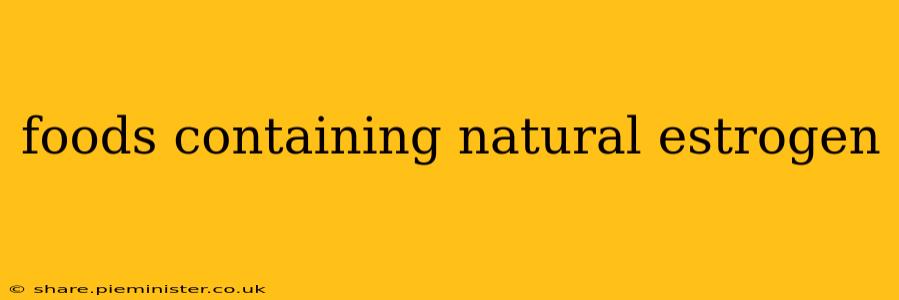Estrogen, a crucial hormone for both men and women, plays a vital role in various bodily functions, from reproductive health to bone density. While our bodies produce estrogen naturally, certain foods contain plant-based compounds called phytoestrogens that mimic the effects of estrogen. This guide explores foods rich in phytoestrogens and clarifies the role they play in our health. It’s important to remember that while these foods offer potential benefits, they shouldn't replace medical advice, and individual responses can vary significantly.
What are Phytoestrogens?
Phytoestrogens are plant-based compounds that share a similar structure to estrogen and can interact with the body's estrogen receptors. This interaction can produce estrogen-like effects, although generally weaker than those from human estrogen. They are found in a variety of plant-based foods and are considered a type of polyphenol. Their impact on the human body is still a subject of ongoing research, with varying results depending on factors like individual genetics and the amount consumed.
What Foods Contain Natural Estrogen (Phytoestrogens)?
Many foods are naturally rich in phytoestrogens. Here are some of the most prominent examples categorized for easier understanding:
Soy Products: A Rich Source of Isoflavones
Soybeans and their derivatives are widely known for their high isoflavone content. Isoflavones are a type of phytoestrogen that includes genistein and daidzein.
- Soybeans: The foundation of many soy products, soybeans themselves pack a powerful phytoestrogen punch.
- Tofu: A versatile and popular soy product, tofu is a good source of isoflavones.
- Tempeh: Fermented soybeans, tempeh offers a different texture and flavor profile while maintaining a good source of phytoestrogens.
- Edamame: Young soybeans, often enjoyed as a snack, are another excellent source.
- Soy milk: A plant-based milk alternative, soy milk also provides isoflavones, though the amount varies between brands.
Flaxseeds: A Lignans Powerhouse
Flaxseeds are an excellent source of lignans, another type of phytoestrogen.
- Flaxseeds (whole or ground): Consuming whole or ground flaxseeds is an effective way to increase your lignan intake. Ground flaxseeds are more easily digested and absorbed by the body.
- Flaxseed oil: While flaxseed oil is rich in omega-3 fatty acids, it contains fewer lignans than whole flaxseeds.
Other Notable Sources of Phytoestrogens:
Beyond soy and flaxseeds, several other foods contribute to phytoestrogen intake:
- Sesame Seeds: These tiny seeds are a surprising source of phytoestrogens.
- Dried Fruits (especially chickpeas, lentils and beans): Lentils, chickpeas, and other legumes contain phytoestrogens, though in smaller amounts than soy.
- Whole Grains: Whole grains like oats, barley, and wheat contain some phytoestrogens, primarily lignans.
- Fruits and Vegetables: Many fruits and vegetables, including apples, berries, and carrots, offer phytoestrogens, but typically in smaller concentrations.
Are There Risks Associated with Eating Foods High in Phytoestrogens?
The potential risks associated with consuming high amounts of phytoestrogens are a subject of ongoing scientific debate. While generally considered safe, some potential concerns include:
- Hormonal Imbalance: High levels of phytoestrogens could theoretically disrupt the body's natural hormone balance, although evidence of significant adverse effects in healthy individuals is limited. This is particularly relevant to those with existing hormone-sensitive conditions.
- Thyroid Issues: Some research suggests a potential link between high phytoestrogen intake and thyroid function in certain individuals. However, more research is needed to definitively establish a causal relationship.
How Much Phytoestrogen is Too Much?
There isn't a universally agreed-upon safe upper limit for phytoestrogen intake. The amount that might cause issues varies greatly between individuals. Moderation is key. Focus on incorporating a diverse range of plant-based foods into your diet rather than relying solely on high-phytoestrogen sources.
Can Phytoestrogens Help with Menopausal Symptoms?
Many women look to phytoestrogens for relief from menopausal symptoms like hot flashes and night sweats. While some studies suggest potential benefits, the evidence is not conclusive, and individual responses vary significantly. It's crucial to consult a healthcare professional before using phytoestrogens to manage menopausal symptoms.
Do Men Need to Worry About Phytoestrogens?
Men also consume phytoestrogens through their diet, but the impact is generally considered less significant than in women due to differences in hormone levels and receptor sensitivity.
Conclusion
Foods rich in phytoestrogens offer a variety of potential health benefits, but more research is needed to fully understand their impact. A balanced diet that includes a variety of fruits, vegetables, and whole grains is always recommended, and individuals with concerns or pre-existing conditions should consult a healthcare professional before making significant dietary changes. The information provided here is for educational purposes and should not be considered medical advice.
